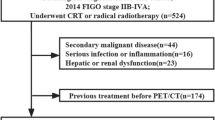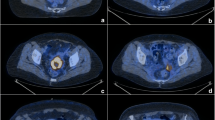Abstract
Purpose
This prospective study aimed to evaluate whether 18F-FDG-PET/CT performed before, during and after neoadjuvant chemo-radiotherapy (CRT) could predict histopathological response in patients with locally advanced cervical cancer (LACC) treated with CRT followed by radical surgery.
Methods
Between October 2010 and June 2014, 88 patients with LACC were enrolled. For each patient, three 18F-FDG-PET/CT scans (baseline, early and final) were acquired and evaluated by qualitative and quantitative analysis. Maximum standardized uptake value (SUVmax), SUVmean, metabolic tumor volume (MTV) and total lesion glycolysis (TLG) were measured as absolute values and their percentage variation (delta) (early vs. baseline and final vs. baseline). The role of 18F-FDG-PET/CT in predicting lymph node (LN) residual disease was evaluated by qualitative analysis only. Histopathology was the reference standard.
Results
At histopathology, 40 patients had complete response (CR, pR0), 48 had partial response (PR: 21 microscopic [pR1] and 27 macroscopic [pR2]). At baseline, SUVmax and SUVmean were significantly higher in pR0 than in pR1–pR2 patients. At early evaluation, MTV and TLG were significantly higher in pR1–pR2 than in pR0 patients. At final evaluation, SUVmax, SUVmean and TLG were significantly higher in pR1–pR2 than in pR0 patients. Delta SUV parameters and delta TLG were significantly lower in PR group both during and after CRT. Delta MTV was significantly lower in patients with PR in the early phase only. In receiver operating characteristic (ROC) curve analysis, baseline SUVmean, early delta TLG, and final delta SUVmax better discriminated PR, providing 83.3%, 67.6% and 85% positive predictive value (PPV) and 60.3%, 90% and 70.8% negative predictive value (NPV), respectively. For LN assessment, high NPV was observed at early and final 18F-FDG-PET/CT (93.5% and 92.3%, respectively).
Conclusion
In LACC patients treated with CRT followed by surgery, early variations in metabolic parameters effectively discriminate histopathological PR of the primary tumor, suggesting the potential role of 18F-FDG-PET/CT in early personalized treatment. The high NPV of early and final PET/CT could enable “tailored surgery” by avoiding lymphadenectomy in selected patients.



Similar content being viewed by others
References
Ferlay J, Soerjomataram I, Dikshit R, et al. Cancer incidence and mortality worldwide: sources, methods and major patterns in GLOBOCAN 2012. Int J Cancer. 2015;136:E359–86. https://doi.org/10.1002/ijc.29210.
Patel DA, Barnholtz-Sloan JS, Patel MK, Malone JM, Chuba PJ, Schwartz K. A population-based study of racial and ethnic differences in survival among women with invasive cervical cancer: analysis of surveillance, epidemiology, and end results data. Gynecol Oncol. 2005;97(2):550–8.
Cibula D, Pötter R, Planchamp F, et al. The European Society of Gynaecological Oncology/European Society for Radiotherapy and Oncology/European Society of Pathology guidelines for the management of patients with cervical cancer. Radiother Oncol. 2018;127:404–16. https://doi.org/10.1016/j.radonc.2018.03.003.
Quinn MA, Benedet JL, Odicino F, et al. Carcinoma of the cervix uteri. FIGO 26th annual report on the results of treatment in gynecological cancer. Int J Gynaecol Obstet. 2006;95(1):S43–103.
Espenel S, Garcia MA, Trone JC, et al. From IB2 to IIIB locally advanced cervical cancers: report of a ten-year experience. Radiat Oncol. 2018;13(1):16. https://doi.org/10.1186/s13014-018-0963-8.
Grigsby PW. The prognostic value of PET and PET/CT in cervical cancer. Cancer Imaging. 2008;8:146–55. https://doi.org/10.1102/14707330.2008.0022.
Herrera FG, Prior JO. The role of PET/CT in cervical cancer. Front Oncol. 2013;3:34. https://doi.org/10.3389/fonc.2013.00034.
Ferrandina G, Legge F, Fagotti A, et al. Preoperative concomitant chemoradiotherapy in locally advanced cervical cancer: safety, outcome, and prognostic measures. Gynecol Oncol. 2007;107(1):S127–32.
Classe JM, Rauch P, Rodier JF, et al. Surgery after concurrent chemoradiotherapy and brachytherapy for the treatment of advanced cervical cancer: morbidity and outcome: results of a multicenter study of the GCCLCC (Groupe des Chirurgiens de Centre de Lutte Contre le Cancer). Gynecol Oncol. 2006;102(3):523–9.
Houvenaeghel G, Lelievre L, Gonzague-Casabianca L, et al. Long-term survival after concomitant chemoradiotherapy prior to surgery in advanced cervical carcinoma. Gynecol Oncol. 2006;100(2):338–43.
Ferrandina G, Margariti PA, Smaniotto D, et al. Long-term analysis of clinical outcome and complications in locally advanced cervical cancer patients administered concomitant chemoradiation followed by radical surgery. Gynecol Oncol. 2010;119(3):404–10. https://doi.org/10.1016/j.ygyno.2010.08.004.
Fanfani F, Vizza E, Landoni F, et al. Radical hysterectomy after chemoradiation in FIGO stage III cervical cancer patients versus chemoradiation and brachytherapy: complications and 3-years survival. Eur J Surg Oncol. 2016;42(10):1519–25. https://doi.org/10.1016/j.ejso.2016.05.011.
Wei LC, Li X, Zhang Y, et al. Individualized pelvic lymphadenectomy should follow neoadjuvant concurrent chemoradiotherapy for locally advanced cervical cancer. Medicine (Baltimore). 2018;97(14):e0331. https://doi.org/10.1097/MD.0000000000010331.
Ferrandina G, Ercoli A, Fagotti A, et al. Completion surgery after concomitant chemoradiation in locally advanced cervical cancer: a comprehensive analysis of pattern of postoperative complications. Ann Surg Oncol. 2014;21(5):1692–9. https://doi.org/10.1245/s10434-013-3471-y.
Grigsby PW, Siegel BA, Dehdashti F. Lymph node staging by positron emission tomography in patients with carcinoma of the cervix. J Clin Oncol. 2001;19(17):3745–9.
Khan SR, Rockall AG, Barwick TD. Molecular imaging in cervical cancer. Q J Nucl Med Mol Imaging. 2016;60(2):77–92.
Kidd EA, Thomas M, Siegel BA, Dehdashti F, Grigsby PW. Changes in cervical cancer FDG uptake during chemoradiation and association with response. Int J Radiat Oncol Biol Phys. 2013;85(1):116–22. https://doi.org/10.1016/j.ijrobp.2012.02.056.
Ferrari M, Travaini LL, Ciardo D, et al. Interim (18)FDG PET/CT during radiochemotherapy in the management of pelvic malignancies: a systematic review. Crit Rev Oncol Hematol. 2017;113:28–42. https://doi.org/10.1016/j.critrevonc.2017.02.019.
Testa AC, Ferrandina G, Moro F, et al. PRospective imaging of CErvical cancer and neoadjuvant treatment (PRICE) study: role of ultrasound to predict partial response in locally advanced cervical cancer patients undergoing chemoradiation and radical surgery. Ultrasound Obstet Gynecol. 2018;51(5):684–95. https://doi.org/10.1002/uog.17551.
Testa AC, Moro F, Pasciuto T, et al. PRspective imaging of cervical cancer and neoadjuvant treatment (PRICE) study: role of ultrasound to assess residual tumor in locally advanced cervical cancer patients undergoing chemoradiation and radical surgery. Ultrasound Obstet Gynecol. 2018;52(1):110–8. https://doi.org/10.1002/uog.18953.
Valentini AL, Miccò M, Gui B, et al. The PRICE study: the role of conventional and diffusion-weighted magnetic resonance imaging in assessment of locally advanced cervical cancer patients administered by chemoradiation followed by radical surgery. Eur Radiol. 2018;28(6):2425–35. https://doi.org/10.1007/s00330-017-5233-x.
Gui B, Miccò M, Valentini AL, Cambi F, Pasciuto T, Testa A, et al. Prospective multimodal imaging assessment of locally advanced cervical cancer patients administered by chemoradiation followed by radical surgery-the "PRICE" study 2: role of conventional and DW-MRI. Eur Radiol. 2018. https://doi.org/10.1007/s00330-018-5768-5.
Choi HJ, Ju W, Myung SK, Kim Y. Diagnostic performance of computer tomography, magnetic resonance imaging, and positron emission tomography or positron emission tomography/computer tomography for detection of metastatic lymph nodes in patients with cervical cancer: meta-analysis. Cancer Sci. 2010 Jun;101(6):1471–9. https://doi.org/10.1111/j.1349-7006.2010.01532.x.
Werner-Wasik M, Nelson AD, Choi W, et al. What is the best way to contour lung tumors on PET scans? Multiobserver validation of a gradient-based method using a NSCLC digital PET phantom. Int J Radiat Oncol Biol Phys. 2012;82(3):1164–71. https://doi.org/10.1016/j.ijrobp.2010.12.055.
Dibble EH, Alvarez AC, Truong MT, Mercier G, Cook EF, Subramaniam RM. 18F-FDG metabolic tumor volume and total glycolytic activity of oral cavity and oropharyngeal squamous cell cancer: adding value to clinical staging. J Nucl Med. 2012;53(5):709–15. https://doi.org/10.2967/jnumed.111.099531.
Eisenhauer EA, Therasse P, Bogaerts J, et al. New response evaluation criteria in solid tumours: revised RECIST guideline (version 1.1). Eur J Cancer. 2009;45(2):228–47. https://doi.org/10.1016/j.ejca.2008.10.026.
Zannoni GF, Vellone VG, Carbone A. Morphological effects of radiochemotherapy on cervical carcinoma. Int J Gynecol Pathol. 2008;27(2):274–81. https://doi.org/10.1097/PGP.0b013e31815b1263.
Kidd EA, Siegel BA, Dehdashti F, Grigsby PW. The standardized uptake value for F-18 fluorodeoxyglucose is a sensitive predictive biomarker for cervical cancer treatment response and survival. Cancer. 2007;110(8):1738–44.
Onal C, Reyhan M, Parlak C, Guler OC, Oymak E. Prognostic value of pretreatment 18F-fluorodeoxyglucose uptake in patients with cervical cancer treated with definitive chemoradiotherapy. Int J Gynecol Cancer. 2013;23(6):1104–10. https://doi.org/10.1097/IGC.0b013e3182989483.
Voglimacci M, Gabiache E, Lusque A, et al. Chemoradiotherapy for locally advanced cervix cancer without aortic lymph node involvement: can we consider metabolic parameters of pretherapeutic FDG-PET/CT for treatment tailoring? Eur J Nucl Med Mol Imaging. 2019. https://doi.org/10.1007/s00259-018-4219-5.
Sarker A, Im H-J, Cheon GJ, et al. Prognostic implications of the SUVmax of primary tumors and metastatic lymph node measured by 18F-FDG PET in patients with uterine cervical cancer: a meta-analysis. Clin Nucl Med. 2016;41(1):34–40. https://doi.org/10.1097/RLU.0000000000001049.
Bos R, van der Hoeven JJM, van der Wall E, et al. Biologic correlates of 18Fluorodeoxyglucose uptake in human breast cancer measured by positron emission tomography. J Clin Oncol. 2002;20(2):379–87.
Ferrandina G, Distefano M, Mascilini F, et al. Could lymphadenectomy be avoided in locally advanced cervical cancer patients administered preoperative chemoradiation? A large-scale retrospective study. Eur J Surg Oncol. 2017;43(12):2270–6. https://doi.org/10.1016/j.ejso.2017.09.013.
Ferrandina G, Petrillo M, Restaino G, et al. Can radicality of surgery be safely modulated on the basis of MRI and PET/CT imaging in locally advanced cervical cancer patients administered preoperative treatment? Cancer. 2012;118(2):392–403. https://doi.org/10.1002/cncr.26317.
Miccò M, Vargas HA, Burger IA, et al. Combined pre-treatment MRI and 18F-FDG PET/CT parameters as prognostic biomarkers in patients with cervical cancer. Eur J Radiol. 2014;83(7):1169–76. https://doi.org/10.1016/j.ejrad.2014.03.024.
Herrera FG, Breuneval T, Prior JO, Bourhis J, Ozsahin M. [(18)F]FDG-PET/CT metabolic parameters as useful prognostic factors in cervical cancer patients treated with chemo-radiotherapy. Radiat Oncol. 2016;11:43. https://doi.org/10.1186/s13014-016-0614-x.
Ueno Y, Lisbona R, Tamada T, Alaref A, Sugimura K, Reinhold C. Comparison of FDG PET metabolic tumour volume versus ADC histogram: prognostic value of tumour treatment response and survival in patients with locally advanced uterine cervical cancer. Br J Radiol. 2017;90(1075):20170035. https://doi.org/10.1259/bjr.20170035.
Lima GM, Matti A, Vara G, et al. Prognostic value of posttreatment (18)F-FDG PET/CT and predictors of metabolic response to therapy in patients with locally advanced cervical cancer treated with concomitant chemoradiation therapy: an analysis of intensity- and volume-based PET parameters. Eur J Nucl Med Mol Imaging. 2018;45(12):2139–46. https://doi.org/10.1007/s00259-018-4077-1.
Scher N, Castelli J, Depeursinge A, et al. ((18)F)-FDG PET/CT parameters to predict survival and recurrence in patients with locally advanced cervical cancer treated with chemoradiotherapy. Cancer Radiother. 2018;22(3):229–35. https://doi.org/10.1016/j.canrad.2017.10.003.
Im HJ, Bradshaw T, Solaiyappan M, Cho SY. Current methods to define metabolic tumor volume in positron emission tomography: which one is better? Nucl Med Mol Imaging. 2018;52(1):5–15. https://doi.org/10.1007/s13139-017-0493-6.
Yang F, Thomas MA, Dehdashti F, Grigsby PW. Temporal analysis of intratumoral metabolic heterogeneity characterized by textural features in cervical cancer. Eur J Nucl Med Mol Imaging. 2013;40(5):716–27. https://doi.org/10.1007/s00259-012-2332-4.
Yang F, Young L, Grigsby P. Predictive value of standardized intratumoral metabolic heterogeneity in locally advanced cervical cancer treated with chemoradiation. Int J Gynecol Cancer. 2016;26(4):777–84. https://doi.org/10.1097/IGC.0000000000000616.
Chong GO, Lee WK, Jeong SY, et al. Prognostic value of intratumoral metabolic heterogeneity on F-18 fluorodeoxyglucose positron emission tomography/computed tomography in locally advanced cervical cancer patients treated with concurrent chemoradiotherapy. Oncotarget. 2017;8(52):90402–12. https://doi.org/10.18632/oncotarget.18769.
Acknowledgments
The authors thank Antonella Stefanelli M.D., Margherita Lorusso M.D. and Arnaldo Abbate for their contribution in data collection.
Author information
Authors and Affiliations
Corresponding author
Ethics declarations
Conflict of interest
The authors declare that they have no conflict of interest.
Ethical approval
All procedures performed in studies involving human participants were in accordance with the ethical standards of the institutional and/or national research committee and with the 1964 Helsinki declaration and its later amendments or comparable ethical standards.
Financial support
None.
Additional information
Publisher’s note
Springer Nature remains neutral with regard to jurisdictional claims in published maps and institutional affiliations.
This article is part of the Topical Collection on Oncology – Genitourinary
Rights and permissions
About this article
Cite this article
Rufini, V., Collarino, A., Calcagni, M.L. et al. The role of 18F-FDG-PET/CT in predicting the histopathological response in locally advanced cervical carcinoma treated by chemo-radiotherapy followed by radical surgery: a prospective study. Eur J Nucl Med Mol Imaging 47, 1228–1238 (2020). https://doi.org/10.1007/s00259-019-04436-y
Received:
Accepted:
Published:
Issue Date:
DOI: https://doi.org/10.1007/s00259-019-04436-y




